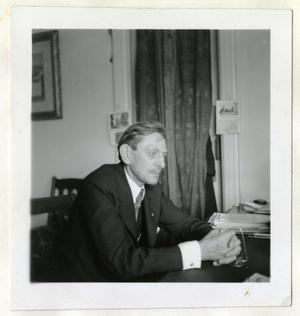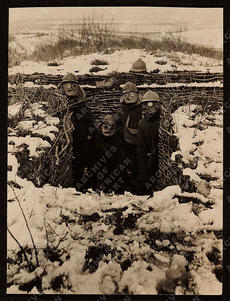 Former Smithsonian Secretary Leonard Carmichael said to Paul Bartsch: "some people are born to live many lives, and you are certainly one of them." On a trip to the Philippines in the 1930s, Bartsch, a curator in the US National Museum's (now the National Museum of Natural History) Division of Mollusks, reported that he saw a sea serpent. While others would have been skeptical, he was merely surprised at the incident, saying "I don’t think anything has quite so excited me as that vision." Though it turned out to be only porpoises, Bartsch's willingness to believe that he had seen a mythical creature reveals the ability to see extraordinary in the ordinary world that would inform his entire career. Bartsch's single-minded devotion to science was as much a part of his personality as his flights of fancy. On another trip to the Caribbean his ship hit a storm, his captain panicked, his crew pumped water all night, and his uncaulked boat almost sank, yet he still refused to go ashore. According to him, the situation was under control as long as "everybody could swim."
Former Smithsonian Secretary Leonard Carmichael said to Paul Bartsch: "some people are born to live many lives, and you are certainly one of them." On a trip to the Philippines in the 1930s, Bartsch, a curator in the US National Museum's (now the National Museum of Natural History) Division of Mollusks, reported that he saw a sea serpent. While others would have been skeptical, he was merely surprised at the incident, saying "I don’t think anything has quite so excited me as that vision." Though it turned out to be only porpoises, Bartsch's willingness to believe that he had seen a mythical creature reveals the ability to see extraordinary in the ordinary world that would inform his entire career. Bartsch's single-minded devotion to science was as much a part of his personality as his flights of fancy. On another trip to the Caribbean his ship hit a storm, his captain panicked, his crew pumped water all night, and his uncaulked boat almost sank, yet he still refused to go ashore. According to him, the situation was under control as long as "everybody could swim."
Bartsch did not just spend his life researching—he let his research become his life. A colleague entrusted him with a rare parakeet, who Bartsch referred to as "a member of the family," and napped cheek to cheek with him every day. Bartsch also played host to a less adorable pet: when one reporter questioned why he was limping, and Bartch responded matter-of-factly that "I got one of those little island creatures in my foot and . . . I am letting him develop there so that we can use him as a specimen."
 One of Bartsch's home experiments had consequences that reverberated far outside the Smithsonian. In the early 20th century, when some slugs (Limax maximus) Bartsch had in his home escaped into his furnace room, he noticed that the slugs were "sensitive" to the furnace fumes and decided to do some more tests. He concluded from the tests that in relatively low concentrations of gas, slugs would be "visibly distressed" by gas. Though initially Bartsch "had not thought of any . . . use for [the] simple observations while . . .studying the humble and unlovely little creature," his studies turned out to be remarkably prescient when American troops were falling prey to mustard gas during World War I. For humans to be able to detect mustard gas in the air, the particles must be present in the concentration of one per 4,000,000 parts of air—oftentimes by the time they were noticed, it was already too late. However, Bartsch's slugs could detect one particle per 10–12,000,000 particles of air, and would visibly indicate their discomfort, allowing soldiers in the trenches to put on their gas masks before they were exposed to harmful levels of gas. Bartsch ran some final tests, and sent the US Army a report that ended up saving many lives. Bartsch went on to do other work for the armed forces after the war, including helping the US Navy preserve their boats as they were sitting in the water, and helping to prevent diseases that were transmitted through mollusks.
One of Bartsch's home experiments had consequences that reverberated far outside the Smithsonian. In the early 20th century, when some slugs (Limax maximus) Bartsch had in his home escaped into his furnace room, he noticed that the slugs were "sensitive" to the furnace fumes and decided to do some more tests. He concluded from the tests that in relatively low concentrations of gas, slugs would be "visibly distressed" by gas. Though initially Bartsch "had not thought of any . . . use for [the] simple observations while . . .studying the humble and unlovely little creature," his studies turned out to be remarkably prescient when American troops were falling prey to mustard gas during World War I. For humans to be able to detect mustard gas in the air, the particles must be present in the concentration of one per 4,000,000 parts of air—oftentimes by the time they were noticed, it was already too late. However, Bartsch's slugs could detect one particle per 10–12,000,000 particles of air, and would visibly indicate their discomfort, allowing soldiers in the trenches to put on their gas masks before they were exposed to harmful levels of gas. Bartsch ran some final tests, and sent the US Army a report that ended up saving many lives. Bartsch went on to do other work for the armed forces after the war, including helping the US Navy preserve their boats as they were sitting in the water, and helping to prevent diseases that were transmitted through mollusks.

Related Collections
- Record Unit 7089 - Paul Bartsch Papers, 1901-1963, Smithsonian Institution Archives
- Record Unit 9519 - Harold A. Rehder Oral History Collection, Interviews by Pamela M. Henson, 1976-1977, Smithsonian Institution Archives
Produced by the Smithsonian Institution Archives. For copyright questions, please see the Terms of Use.

Leave a Comment